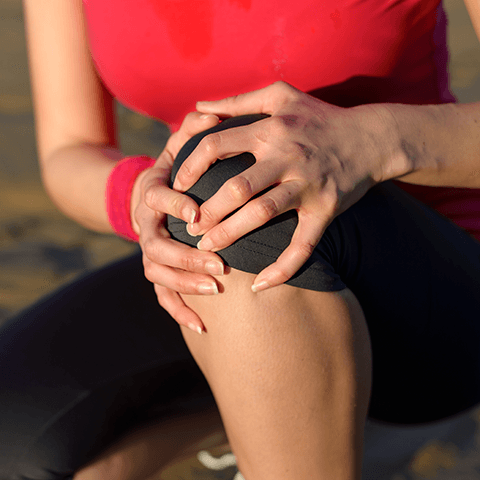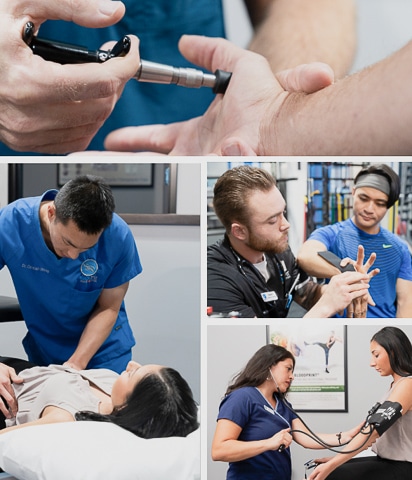Knee Pain

Appointment Inquiries
Call us at: (877) 222-5348
Definition
Pain that occurs in or around the knee
Root Causes
Decreased Range of Motion, Fever, Inability to Fully Straighten he Knee, Popping or crunching noises, Redness, Sensitivity, Stiffness, Swelling
Risk Factors
Age, Arthritis, Lack of Flexibility, Lack of Strength, Sports Injury
Treatments
Chiropractic, Customized Knee Support Braces, Orthopedic Sports Medicine, Physical Therapy
What is knee pain?
Knee pain is defined as stiffness, swelling, sensitivity, or pain in one or both knees. The location and severity of knee pain may vary depending on the cause. Knee problems can also start as mild discomfort and progressively get worse. It is often caused by injury, misalignment, or degeneration.
According to a study, knee pain is very common affecting 25% of all adults, accounting for 4 million doctor visits per year. Perhaps surprisingly, the knee is also the largest joint in the body and one of the most complex. It is a compound hinge joint allowing flexion and extension of the lower leg, as well as slight internal and external rotation.
What are the symptoms of knee pain?
When your knee hurts, simple everyday activities such as standing and walking can become difficult or impossible. You may notice that you have trouble going up or downstairs or getting out of bed.
Other than pain, you may also notice:
- Decreased range of motion
- Deformation
- Fever
- Popping or crunching noises
- Redness
- Sensitivity
- Stiffness
- Swelling
- Trouble straightening or bending
- Warm to the touch
You may also not be able to put much or any weight on it or it feels unstable.
Causes
Injury is the most common cause of knee pain. Some knee injuries respond well to self-care measures, but others require physical therapy, knee braces, medication, or injections. In some rare cases, surgical intervention is necessary.
Common injuries, especially from sports accidents, include:
- ACL (anterior cruciate ligament) injury or tear
- Cruciate ligament injury
- Fractures, especially of the patella
- Medial collateral ligament injury or tear
- Torn meniscus
- Bursitis of the knee
- Patellar tendonitis
Mechanical problems of the body can also place unusual stress and strain on muscles, especially in the knee. Pain from mechanical issues are often caused by bad habits like poor posture, non-ergonomic chairs, and incorrect lifting. When the shock absorbers of the knee are injured, it can cause a lot of pain.
Common mechanical problems in the knee include:
- Loose bodies: Bone or knee cartilage that detached interfering with joint movement.
- Iliotibial band (IT band) syndrome: When the ligament that runs from your hip to knee is so tight that it rubs against your femur causing pain.
- Dislocated kneecap (patella): When the bone on the front of your knee slides out of place, usually to the outside of your knee.
- Gait alterations: If you have hip, foot, or other pain while walking causes you to alter your gait to avoid that pain, your knee may compensate and become painful too.
Arthritis is also a major source of knee (and other) joint pain. The types to most likely to affect the knee include osteoarthritis, rheumatoid arthritis, gout, pseudogout, and septic arthritis.
The cause of your knee pain may also be difficult to identify, but that does not make it any less real. This is usually labeled as patellofemoral pain syndrome or “runner’s knee,” and is usually associated with a dull or aching pain in the front of your knee.
Patellofemoral pain is aggravated by stairs, kneeling, squatting, sitting with bended knees for long periods, running, jumping, and other overuse. Doctors don’t know the exact cause but believe that it’s often due to weakness or lack of flexibility in the muscles around the knee and hip.
What are the risk factors of knee pain?
Your chances of experiencing knee pain can increase for a few reasons. Risk factors are higher for:
- Age
- Arthritis
- Lack of flexibility
- Lack of strength
- Obesity
- Sports injury
Further, those that have previously experienced a knee injury are more likely to experience knee pain or injury again.
Prevention
The best way to protect your knee and avoid pain are preventative measures. Although it’s not always possible to prevent, these suggestions may stall injury and deterioration:
- Exercise
- Good posture
- Invest in good shoes
- Practice your gait
- Stretching
- Weight loss
If your job involves lifting or you lift weights, make sure that you’re lifting properly. You should also avoid kneeling on hard surfaces or protect your knees with pads.
What does BackFit do for Knee Pain?
Diagnosis is the first step. As you can see, there are a lot of causes to the symptom of knee pain. Here at BackFit Health + Spine, we provide a hands-on evaluation and, if needed, on-site digital imaging (x-ray and ultrasound). Once we identify the underlying cause, we will discuss the best treatments for you.
Our knee pain treatment options include:
- Chiropractic Adjustments for the knee, hip, foot, and more
- Customized Knee Support Braces
- Natural hyaluronic acid injections
- Physical Therapy with prescribed exercises and stretches
- Orthopedic sports medicine intervention
- Topical analgesic medication
- Weight loss Rx
Painkillers and knee replacement surgery can be costly, painful, and can require a long recovery. BackFit’s goal is for you to avoid these invasive procedures through our non-invasive integrated health care methods.
More About BackFit
Looking to learn more? Explore our locations, treatments, or our new patient offer below or contact one of the BackFit Family of staff to have your questions answered.


